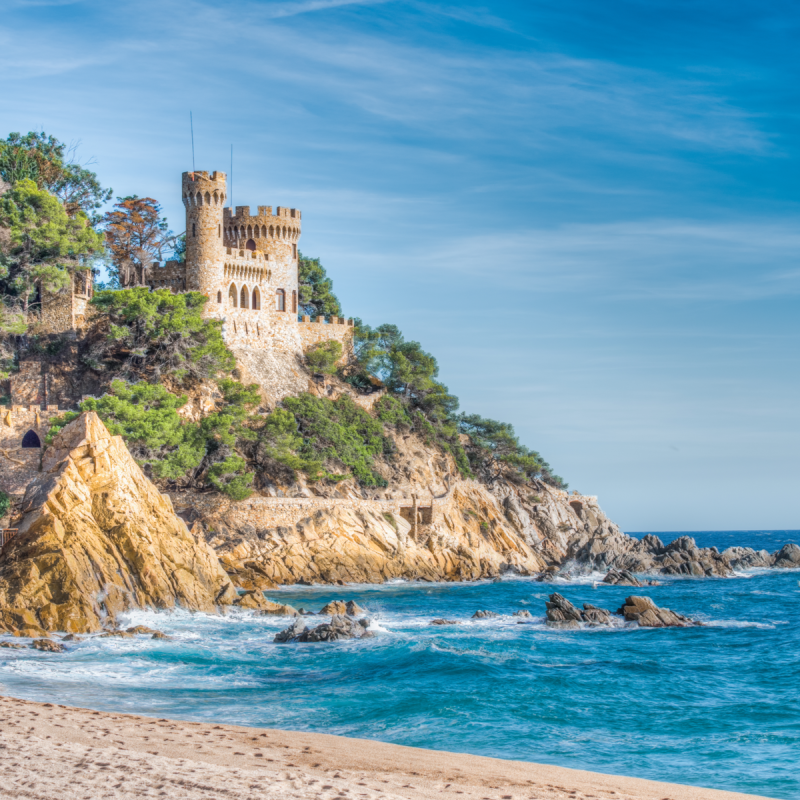
The northeastern coast of Catalonia, Spain, is also known as the Costa Brava, or “wild coast” — and rightfully so. The stretch of seaboard from the French border to the town of Blanes is known for its rugged landscape and wild sea, as well as kayaking, rock climbing, horse riding, and a great many more outdoor activities that will delight travelers who enjoy active vacations — but, on the other hand, love culture, good food, and great company.
Videos by TravelAwaits
Since the 1960s, the Costa Brava, with its unspoiled nature and landscape, has been a popular holiday destination. A lot has been invested in promoting and improving outdoor activities. Of course, the already fabulous beaches, good summer climate, and unlimited possibilities for water sports helped.
Here are the most interesting outdoor activities along Spain’s Costa Brava that will delight the whole family.
1. Sea Swimming
The Costa Brava offers miles of swimmable beaches, but being the destination it is, the waters can be crowded. Look for a beach with Vies Braves.
Catalan long-distance swimmer Miquel Sunyer didn’t see any reason why only the strongest swimmers should have the pleasure to enjoy the clear and beautiful waters of the wild Costa Brava. He came up with the idea to establish secure swimming lanes running parallel with the coast — and soon, the yellow markers of the so-called Vies Braves appeared in the water. Since then, many miles of water all along the coast have been secured and allow everybody the pleasure to swim in the refreshing sea.
2. Kayaking
Kayaking is an especially popular activity because of the many coves and rugged coastline of the Costa Brava. Kayaks are for rent practically everywhere, and there are plenty of schools around that take families on trips or provide lessons for those who never have managed a kayak before. For those who rather want to go on a longer kayaking tour, this 8-hour tour via GetYourGuide will probably be ideal.

3. Exploring Cap De Creus
Cap de Creus Natural Park, located between Cadaqués and Port de la Sella, is a rarity because it is the first maritime and terrestrial park in the country. Apart from preservation and protection, the park boasts an enticing beauty that will fascinate every visitor. The park also contains a monastery and holds many lectures.
4. Horseback Riding
A great outdoor activity is a 4-day, 3-night horse riding adventure at the family-run horse farm Mas Alba. The farm isn’t far from Girona or Barcelona and accommodates riders and horses. Breakfast and one meal daily are also provided. The highlight of this horseback experience is the gallops at dawn and gallops along the beach. This is, however, not for novice riders.
5. Bungee Jumping
As the name already indicates, the Costa Brava isn’t short on exciting activities. One of them is the highest bungee jump in the entire country, a drop of 229 feet in Lloret de Mar. Get excited and book your ticket here.

6. Rock Climbing
As rock climbing on the Costa Brava is concerned, the magic words as far are via ferratas. These are rock climbing routes of various difficulty levels. Along the Costa Brava, they mostly consist of limestone and granite.
The via ferrata near Tossa de Mar, Cala del Molí, is especially enticing because, while you climb or traverse, the turquoise sea churns below your feet. Sant Feliu de Guíxols is the starting point for this route. As opposed to other via ferrata (there are several in the world), this one is quite secured with iron ladders, steel bridges, ropes, and slings.
Another via ferrata, albeit without the seas at your feet, is located at Ribes de Freser.
Before embarking on your climbing tour, with or without a guide, research the proper equipment and bring it with you.
Note: If you suffer from vertigo, rock climbing is not advised.
7. Frolicking In Waterparks
Rock climbing may not be a suitable activity for every member of the family, but the three waterparks of the Costa Brava will bring everyone fun and relaxation. The kids, for whom special sections are set aside, will be in heaven. The parks, Aquadiver Parc in Plajta d’Aro and Water World in Lloret de Mar, are very well equipped with wave pools, rapid rivers, and more.

8. The European Balloon Festival
The first two weeks of July celebrate the Costa Brava’s most spectacular festival, the European Balloon Festival. More than 50 hot air balloons from all over the world gather in Igualada. Igualada is located in the province of Barcelona on the left bank of the Anoia River. Since 1997, hot air ballooners have assembled here to compete and celebrate the sport. The festival attracts over 25,000 visitors per year for four days of entertainment and spectacle. The balloons take to the sky at dawn or dust because those provide the best conditions for the flights.
It’s not only the competitors who can participate: Guests can also fly, and the flight is accompanied by pastries and champagne.
Catch additional magic at the “Night Glow,” when the balloons are illuminated but do not leave their moorings.
9. Exploring The Sea Caves And Beaches
Many sea caves line the shore of the Coast Brava, and some have even fancy names. The Cova de s’Infern (or Cave of Hell) is located directly under the lighthouse of Cap de Creus and gets its devilish name from the red hue the light takes on at a certain angle. Cova d’en Gispert is the longest sea cave on the Costa Brava, and an anecdote tells that Salvador Dalí himself arranged a concert here because the acoustics were so incredible. Another story circulates that, apparently, a Russian woman used to own the cove and ride down to the beach on a donkey to indulge, naked, in her bath.
10. Scuba Diving
This part of the Mediterranean is one of the sea’s most popular diving centers because of its incredible sea bed, rich flora and fauna, and, last but not least, the high quality of its diving schools and centers. Aiguablava, Begur, and Fornells are popular diving sites. Aiguablava is an example of an outstanding sea bed because of the clear, blue that hosts gorgonian coral, meadows of posidonia, and more. All diving schools in the vicinity offer beginner courses.
Other great places to dive along the Costa Brava are Blanes and Cadaqués.

11. Wind- And Kitesurfing
With all this watersport, we cannot overlook wind- and kitesurfing. The beaches of the Costa Brava hands offer themselves for this, and there are certain places where the wind blows favorably.
One of these is the Golf de Roses, or Gulf of Roses, close to the Pyrenees. Your best bet for wind- and kitesurfing in Golf de Roses is booking through the ION Club, an international watersports school and center. This has the added advantage that your equipment will be well looked after. The proximity to the Pyrenees means that when you tire of surfing, you can easily switch to other outdoor activities, like hiking or biking in the mountains — and, of course, sampling the delicious food this part of Europe has to offer.
12. Visiting Culturally Rich Cities
Costa Blanca’s most famous artist cannot be forgotten in this list. Salvador Dalí was born in Figueres and came to the charming, white village of Cadaqués. This is the location where his famous house (now Salvador Dalí House Museum) stands and attracts thousands of visitors every year. But it is not only the artistic and romantic atmosphere of Cadaqués that brings visitors here — it’s also the gorgeous beaches and the enchanting Cap de Creus Natural Park.
But Cadaqués does not feature the only monument to Dalí on the Costa Brava. There is also his hometown of Figueres, a rather bizarre place with a theater that Dalí converted into his private museum. A medieval tower still stands as part of the building, which is painted red with white eggs on top. Dalí was eccentric.

13. Hiking Footpaths Along The Coast
Hiking is one of the most popular and healthy outdoor activities. The Costa Brava is blessed with many (all rather easy) coastal footpaths, all with incredible views and some going through such lovely places as Roses, Blanes, and Cadaqués. All the while with the soothing music of the sea in the background.
Here are just three that are very pretty. First is the Montgó Nature Park Trail, which leads between Jávea and Dénia. A rocky path zigzags up the eastern face to the plateau, but apart from the last bit being a bit of a scramble, it isn’t steep. The view over the coast of Dénia is beautiful.
The Paseo Ecológico de Benissa starts at La Fustera Beach and follows the coastline. The walk is very well maintained and, along the way, there are picnic areas where you can rest.
Something a little different is the Guadalest to Altea moonlight walk. You’re in for a romantic night. The walk is organized by the local Spanish Nordic Walking Federation to coincide with the full moon in late July/early August. It leads from the dam in Guadalest to the center in Altea, is around 12 miles long, and lasts approximately 5 hours. The good news is it’s all downhill. Bring long pants, hiking shoes, and headlamps.
Related Reading:

